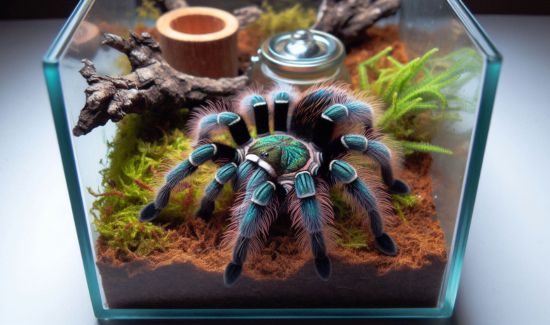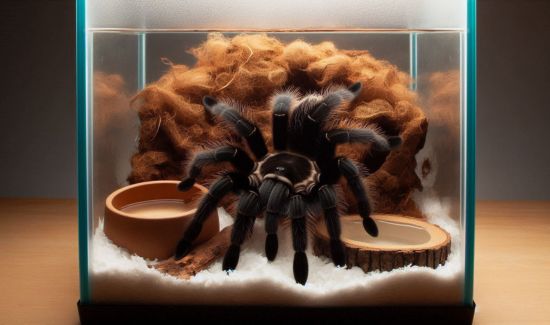If you’re a beginner tarantula enthusiast or have limited space, you might wonder if keeping a tarantula for 5 gallon tank is a good idea. Tarantulas are fascinating creatures that make unique pets, but their housing needs are important to ensure their well-being. In this article, we’ll explore whether a tarantula for 5 gallon tank is suitable for a tarantula, discuss some of the best species that can thrive in such a setup, and provide a guide to setting up and maintaining a small tarantula habitat.
Introduction
Table of Contents
Tarantulas are becoming increasingly popular as pets due to their low maintenance and unique behaviors. However, the key to keeping a tarantula healthy and happy lies in providing the right environment. The size of the tank is a crucial factor that can affect your tarantula’s comfort and lifespan. A 5-gallon tank is relatively small, and not all tarantulas will be comfortable living in such confined spaces. But, if you’re determined to use a 5-gallon tank, there are some tarantula species that can adapt well to this size of the enclosure.
Is a 5-Gallon Tank Suitable for Tarantulas?
When choosing a tank for your tarantula, size matters. Tarantulas need space to move, burrow, and feel secure. A 5-gallon tank is on the smaller side, and while it may work for certain tarantula species, it is essential to ensure that the tank provides enough space for your pet to thrive.
Pros of using a 5-gallon tank for tarantulas:
- Space-saving: Perfect for small living spaces or apartments.
- Cost-effective: Smaller tanks are generally cheaper.
- Easier to maintain: Less substrate and decor required.
Cons of using a 5-gallon tank for tarantulas:
- Limited space: Not suitable for larger tarantulas or those that require more room to roam.
- Temperature regulation: Smaller tanks can be harder to regulate in terms of temperature and humidity.
Top 3 Tarantula for 5 Gallon Tank
Not all tarantulas can live comfortably in a 5-gallon tank, but here are three species that are well-suited for this size of the enclosure:
1. Brazilian Black Tarantula (Grammostola pulchra)
The Brazilian Black Tarantula is a calm and slow-growing species, making it an excellent choice for beginners. This tarantula doesn’t require a lot of space and can adapt well to a 5-gallon tank.
- Size: 4-6 inches
- Lifespan: 15-20 years
- Temperament: Docile and calm
- Suitable for a 5-gallon tank: Yes
2. Chilean Rose Tarantula (Grammostola rosea)
The Chilean Rose Tarantula is another beginner-friendly species known for its docile nature. It is relatively small and doesn’t require much space, making it a good fit for a 5-gallon tank.
- Size: 4-5 inches
- Lifespan: 15-20 years
- Temperament: Calm and hardy
- Suitable for a 5-gallon tank: Yes
3. Mexican Red-Knee Tarantula (Brachypelma hamorii)
The Mexican Red-Knee Tarantula is a colorful and slow-moving species that also adapts well to smaller enclosures. It is a great option for those who want a visually appealing tarantula.
- Size: 5-6 inches
- Lifespan: 20-30 years
- Temperament: Calm and slow-moving
- Suitable for a 5-gallon tank: Yes, but with careful monitoring.
Setting Up a 5-Gallon Tank for Your Tarantula
When setting up a 5-gallon tank for your tarantula, it’s important to focus on creating a safe and comfortable environment. Here are some key aspects to consider:
Substrate
The substrate is crucial for your tarantula’s comfort and safety. Coconut fiber or topsoil are excellent choices, as they allow for burrowing and help maintain humidity.
- Depth: 3-4 inches
- Material: Coconut fiber or topsoil
- Purpose: Helps maintain humidity and allows for burrowing
Hides
Tarantulas need a place to hide and feel secure. A small cork bark or half-log hide can provide the necessary shelter.
- Placement: One hide on the cool side of the tank
- Material: Cork bark or half-log
- Purpose: Provides security and reduces stress

Water Dish
A shallow water dish is essential for hydration. Ensure the dish is shallow enough that the tarantula won’t drown, and change the water regularly to prevent bacteria growth.
- Size: Shallow
- Placement: On the opposite side of the hide
- Purpose: Provides hydration
Temperature and Humidity
Maintaining the right temperature and humidity levels is vital for your tarantula’s health. Most tarantulas require temperatures between 70-80°F and humidity levels of 60-70%.
- Temperature: 70-80°F
- Humidity: 60-70%
- Tools: Use a small thermometer and hygrometer to monitor conditions
Ventilation
Proper ventilation is key to preventing mold growth and ensuring your tarantula has enough oxygen. Make sure the tank has small ventilation holes but not so large that the tarantula can escape.
- Type: Small holes on the top and sides
- Purpose: Prevents mold and ensures proper airflow
Feeding and Care for Tarantulas in a 5-Gallon Tank
Feeding a tarantula in a small tank requires careful consideration. Tarantulas typically eat crickets, mealworms, or roaches. In a 5-gallon tank, it’s essential to ensure the food doesn’t overwhelm the space or stress the tarantula.
- Diet: Crickets, mealworms, or roaches
- Feeding Schedule: Once a week for adults, twice a week for juveniles
- Portion Control: Only provide one or two food items at a time
Cleaning and Maintenance
Maintaining a clean tank is essential to prevent bacteria growth and ensure your tarantula’s health. In a 5-gallon tank, cleaning is relatively easy due to the small size.
- Spot Clean: Remove uneaten food and waste regularly
- Deep Clean: Replace the substrate every 6 months
- Water Dish: Clean and refill the water dish daily
Conclusion
In conclusion, while a 5-gallon tank may not be ideal for all tarantulas, there are certain species that can thrive in such a setup if proper care is taken. Brazilian Black, Chilean Rose, and Mexican Red-Knee tarantulas are among the best choices for smaller enclosures. By carefully setting up the tank, maintaining the right conditions, and providing proper care, you can ensure your tarantula lives a happy and healthy life. Remember, even in a small space, it’s essential to meet your tarantula’s needs for a stress-free environment.
Table of Information: Best Tarantula for 5 Gallon Tank
There is following best tarantula for 5 Gallon tank:
| Tarantula Species | Size | Lifespan | Temperament | Suitable for 5-Gallon Tank? |
|---|---|---|---|---|
| Brazilian Black Tarantula | 4-6 inches | 15-20 years | Docile and calm | Yes |
| Chilean Rose Tarantula | 4-5 inches | 15-20 years | Calm and hardy | Yes |
| Mexican Red-Knee Tarantula | 5-6 inches | 20-30 years | Calm and slow | Yes, with careful monitoring |
FAQs About Tarantula for 5 gallon tank
1. Can all tarantulas live in a 5-gallon tank?
No, not all tarantulas can thrive in such a small space. It’s essential to choose species that are known to adapt well to smaller enclosures.
2. How often should I feed my tarantula in a 5-gallon tank?
For adults, feeding once a week is sufficient. Juveniles may need to be fed twice a week.
3. What is the best substrate for a 5-gallon tarantula tank?
Coconut fiber and topsoil are great choices as they help maintain humidity and allow for burrowing.
4. Do tarantulas need a lot of ventilation in a small tank?
Yes, proper ventilation is crucial to prevent mold growth and ensure your tarantula has enough oxygen.
5. How often should I clean my tarantula’s 5-gallon tank?
Spot clean regularly and perform a deep clean, including replacing the substrate, every 6 months.

